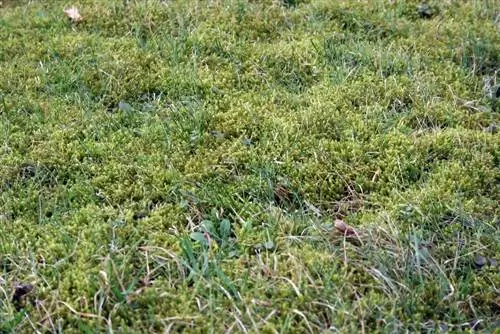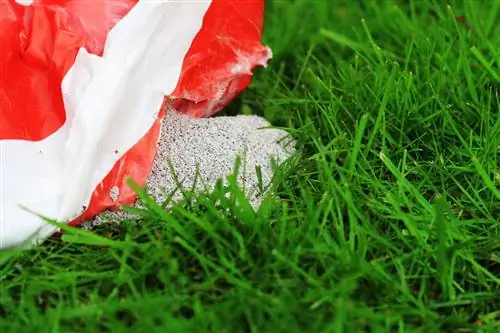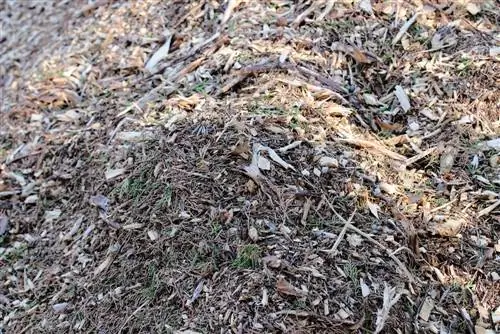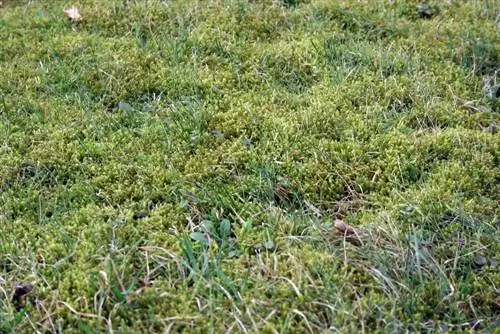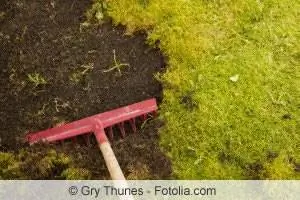- Author admin [email protected].
- Public 2023-12-17 03:39.
- Last modified 2025-06-01 06:48.
By caring for your lawn, fertilizing it and removing weeds, you create significantly better living conditions for the tender grasses. However, in order to have a he althy and beautiful lawn in the garden in the long term, a few further measures are necessary. However, a good start is with a suitable lawn fertilizer against weeds and moss. On the one hand, the fertilizer strengthens the lawn, but on the other hand, it creates unfavorable conditions for weeds. If there is heavy weed growth, a suitable weed killer in the fertilizer can also help combat it.
Nutrients in lawn fertilizer
Unfortunately, weeds in the lawn are much more difficult to remove than in the bed. Many gardeners therefore quickly turn to lawn fertilizer. The choice isn't such a bad one, because where the grass is resilient and strong, weeds have less of a chance. The most common reason for heavy weed and moss growth in the lawn is and remains a severe lack of nutrients. In contrast to lawns, weeds only need very few nutrients. Lawns need a special fertilizer with a high nitrogen content. Phosphorus and potassium are also important. There is also a need for calcium, magnesium, iron and trace elements for he althy growth.
Nitrogen
Ornamental lawns need high nitrogen levels to grow well. Nitrogen ensures green foliage, new shoots and thus a denser spread of the lawn. That's why a good lawn fertilizer should contain a high proportion of nitrogen. However, an oversupply quickly leads to burns.
Phosphate
Phosphate not only promotes root growth, but is also an energy source for the lawn and microorganisms in the soil. By forming new roots, the grass is better anchored in the ground and can absorb other nutrients more optimally. With the help of a dense root system, the lawn can store water better. Plants that are sufficiently supplied with phosphate are more frost-resistant than grasses that are under-supplied and develop significantly faster after a long and cold winter.
An oversupply of phosphate is very harmful because it raises the pH value. Therefore, the use of phosphate should be used sparingly. The nitrogen/phosphorus ratio should not be less than 3:1 (for example 10% N and 3% P or 15% N plus 5% P).
Tip:
The soil pH value can be used to determine the phosphate content: the lower (more acidic) the pH value is in the garden soil, the fewer phosphates it contains.
Potassium
The potassium ensures that the grass can store cell fluid well. This means the plants can survive frosty temperatures better in winter. In order to make the lawn winter-proof, the last fertilization should be in the fall with a potassium-concentrated fertilizer. If the lawn lacks potassium, it becomes susceptible to diseases over the winter months, which is noticeable, for example, in yellowish discoloration. Since potassium also protects against drying out, June fertilization should also contain a little more potassium.
Tip:
The potassium in lawn fertilizer is often present as poorly soluble potassium silicate. Since potassium silicate can only be converted by grass plants in small quantities, in this case it is necessary to additionally fertilize with pure potassium fertilizer.
Magnesium
Plants only need trace amounts of magnesium, which is why it should only be added in small quantities via lawn fertilizer. Although the proportion of magnesium is only in the smallest per mille range, the lawn cannot grow without the mineral. Magnesium is necessary for the formation of chlorophyll, which the plant needs for photosynthesis. Magnesium therefore ensures he althy leaf greenness as a sign of a high proportion of chlorophyll in the leaves of the lawn.
Iron
If there is a high moss content, additional iron fertilizer helps. Iron is at the same time an important nutrient (i.e. fertilizer) for the lawn and a natural moss killer. The most common iron fertilizer is iron sulfate. The remedy - used alone - has the disadvantage that it is not entirely harmless.
calcium
Calcium is also a trace element that the lawn only needs in the lowest concentrations to strengthen the cell walls and develop the root hairs.
Organic or mineral fertilizers?
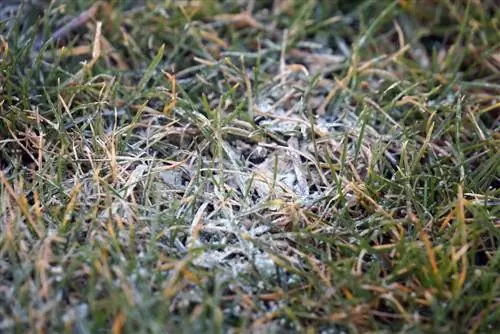
A distinction is made between mineral and organic fertilizers. As a rule, mineral fertilizers contain fast-acting nitrogen compounds in the form of nitrate and ammonium. These compounds dissolve easily in water, so an effect can be seen in just a few days. However, the mineral fertilizer is also washed out more quickly by rainwater and is then no longer available after a short time. Organic fertilizers, on the other hand, contain nitrogen compounds that first have to be broken down by soil organisms. The effect is weaker here, but lasts longer (no risk of over-fertilization). Combinations of both types of fertilizer are therefore best suited to ensure a long-term sufficient supply of nitrogen over the entire growing period.
Special additives for the pH value in the soil
Where there are a lot of weeds growing in the lawn, the soil may be very sandy or compacted. Both conditions are not optimal for the growth of the lawn and should be improved through appropriate measures. But the pH value in the soil also has a major influence on lawn growth and the appearance of moss and weeds in the lawn. That's why it's worth checking the pH value in the garden soil. This can be done quickly and easily with a rapid test, which is available in garden centers, pharmacies or online shops. If the pH value is too acidic (well below 6), this promotes the growth conditions for mosses. In this case, in addition to soil improvement measures, lawn lime or a special soil activator that neutralizes the acid also helps. Lime should no longer be applied from a pH value of around 6.5. You can often tell whether the soil is alkaline or acidic by looking at the vegetation:
- Moss indicates acidic soil
- Clover tends to grow in alkaline soil
Tip:
Be careful if the soil pH value is increased too much! Nutrients such as iron can no longer be absorbed in neutral or alkaline soils (pH values well above 6) because they are in a water-insoluble form.
Weed killer
Anyone who uses weed killers in the lawn must make sure that they are also suitable for use on lawns. Many weed killers (total weed killers, Roundup products) kill everything: weeds, moss - and lawn! When treating lawns, only so-called lawn weed killers may be used. These agents can “distinguish” between lawns and weeds. Lawn weed killers usually contain different active ingredients:
- nature-identical active ingredients
- chemical agents
- synthetic (replicated) plant hormones
- many contain so-called growth substances
- trigger uncontrolled growth in all dicot plants
- no effect on monocotyledonous plants (such as lawns)
- Lawn weeds are usually dicotyledonous plants
- eventually leads to the death of the weeds
- Most products contain two to four different active ingredients
Combined lawn fertilizer and weed killer products
While pure lawn weed killers are usually applied to the lawn in liquid form, there are also combination products of lawn fertilizer and weed killer available on the market. These are available in granular form and can be sprinkled on the lawn. Although these products are particularly easy to use, the weed killer does not work quite as reliably as a liquid preparation. The effectiveness of a weed killer depends heavily on the correct preparation, application and also the weather conditions. Best conditions for effectiveness:
- warm day (no hot temperatures, but no cold either)
- mild night (no frosts)
- moist soil
- do not apply to freshly mown lawn
- Time: late afternoon
- plants that are easy to control: dandelions, white clover, daisies, plantain
- most remedies only have a limited effect on: speedwell, buttercup, sorrel and groundworm
Tip:
Despite their broad effectiveness, not all types of weeds can be controlled with all lawn weed killers. Therefore, check carefully in advance which types of weeds are present and seek advice from specialist retailers.
Conclusion
If site conditions and soil quality are not quite optimal, suitable lawn fertilizers can strengthen the lawn and make life more difficult for weeds. If the lawn has been heavily suppressed by weeds, a combination product with a weed killer makes sense instead of pure lawn fertilizer. In addition to nitrogen (in both mineral and organic form), a good lawn fertilizer contains a small proportion of phosphorus and the trace elements iron, magnesium and calcium. In autumn, lawn fertilizer should contain potassium.
Tips for speed readers
- not all fertilizers are suitable for lawns
- pay attention to the right composition of the fertilizer
- high nitrogen levels and moderate phosphorus levels
- Combined fertilizers made from mineral and organic fertilizers are best
- Potassium (especially in autumn)
- Trace elements such as magnesium and calcium
- Iron against moss
- Measure pH value and adjust if necessary (optimally 6-6, 5)
- pure ornamental lawn: one fertilization in April, one in June
- polluted lawn: further fertilization in autumn (potassium emphasized)
- March to April: first fertilization depending on the weather
- start weed control
- June: second fertilization (maintenance fertilization)
- July and August: do not fertilize (too warm and dry)
- September to October: Potassium-stressed fertilizer
- November to February: no fertilization

